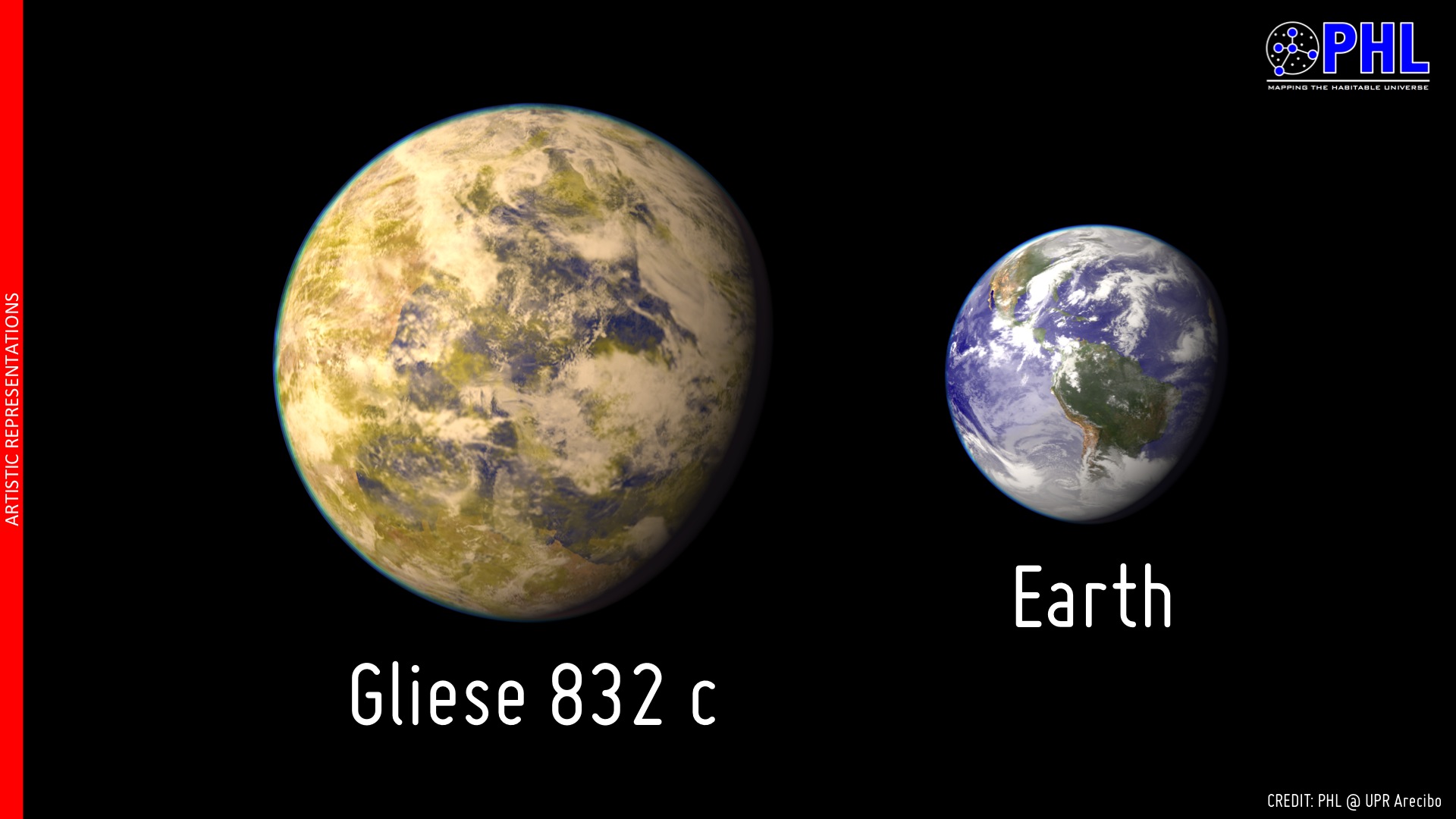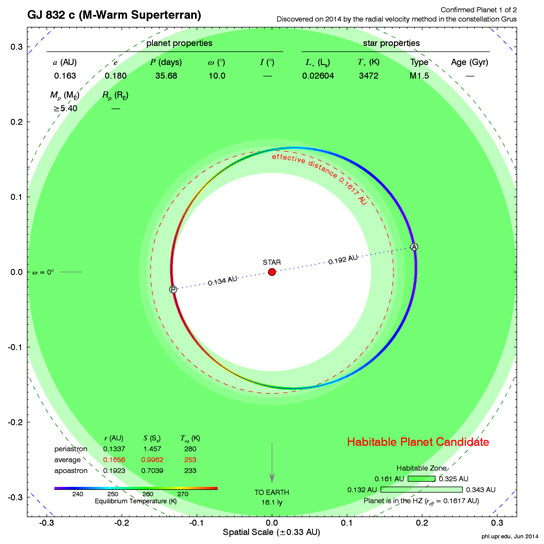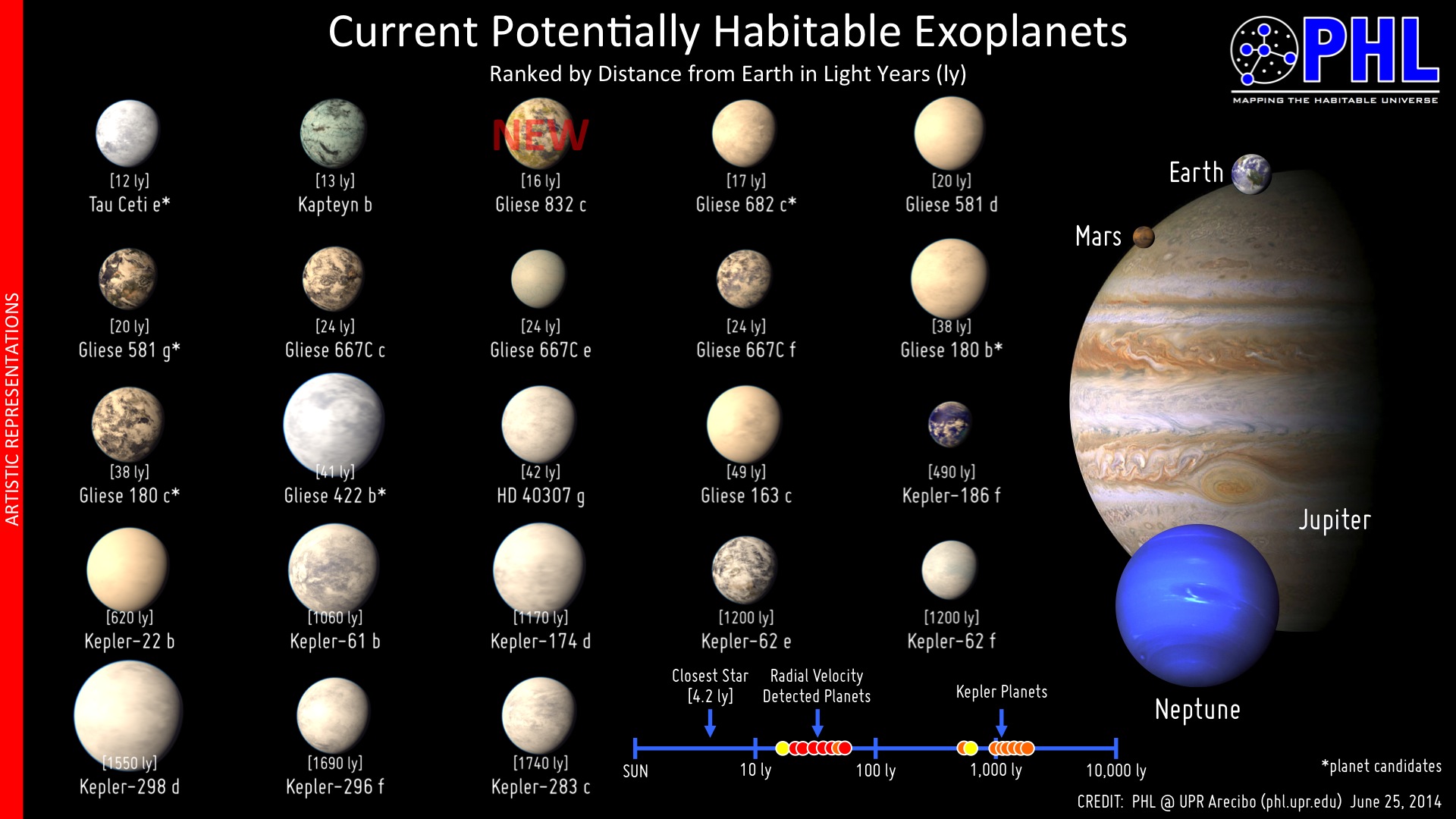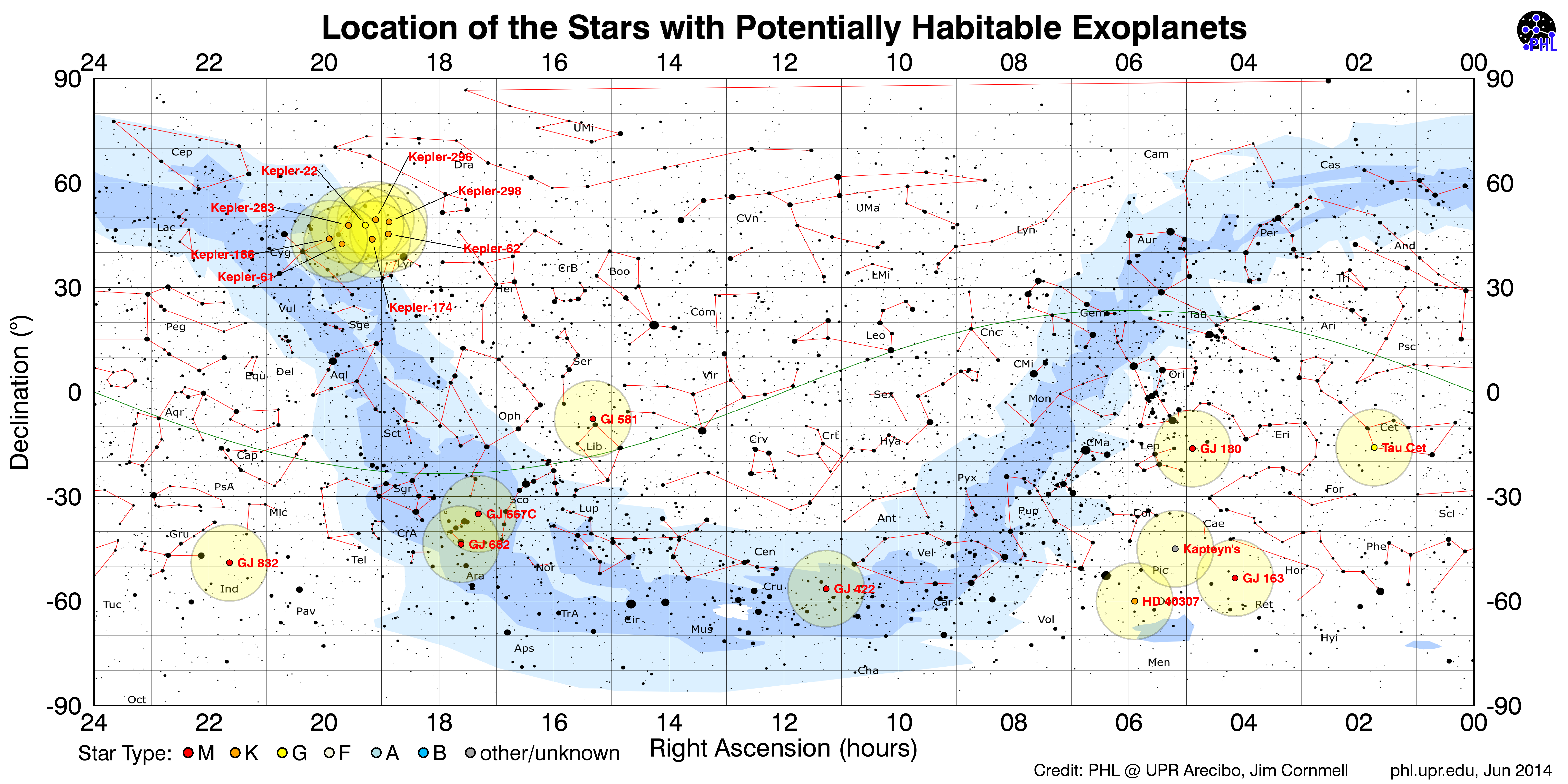New Mars Forums
You are not logged in.
- Topics: Active | Unanswered
Announcement
#1 2014-06-30 06:26:30
- Tom Kalbfus
- Banned
- Registered: 2006-08-16
- Posts: 4,401
What is opposite of Mars?
Maybe this planet:
http://phl.upr.edu/press-releases/gliese832
Press Releases >
A Nearby Super-Earth with the Right Temperature but Extreme Seasons
posted Jun 25, 2014, 4:53 AM by Abel Mendez Torres [ updated 5 hours ago ] 
Artistic representation of the potentially habitable Super-Earth Gliese 832 c against a stellar nebula background. Credit: PHL @ UPR Arecibo, NASA Hubble, Stellarium.
UPDATE: Check figure 5 for an alternative version.
Gliese 832 c is the nearest best habitable world candidate so far
An international team of astronomers, led by Robert A. Wittenmyer from UNSW Australia, report the discovery of a new potentially habitable Super-Earth around the nearby red-dwarf star Gliese 832, sixteen light years away. This star is already known to harbour a cold Jupiter-like planet, Gliese 832 b, discovered on 2009. The new planet, Gliese 832 c, was added to the Habitable Exoplanets Catalog along with a total of 23 objects of interest. The number of planets in the catalog has almost doubled this year alone.
Gliese 832 c has an orbital period of 36 days and a mass at least five times that of Earth's (≥ 5.4 Earth masses). It receives about the same average energy as Earth does from the Sun. The planet might have Earth-like temperatures, albeit with large seasonal shifts, given a similar terrestrial atmosphere. A denser atmosphere, something expected for Super-Earths, could easily make this planet too hot for life and a "Super-Venus" instead.
The Earth Similarity Index (ESI) of Gliese 832 c (ESI = 0.81) is comparable to Gliese 667C c (ESI = 0.84) and Kepler-62 e (ESI = 0.83). This makes Gliese 832 c one of the top three most Earth-like planets according to the ESI (i.e. with respect to Earth's stellar flux and mass) and the closest one to Earth of all three, a prime object for follow-up observations. However, other unknowns such as the bulk composition and atmosphere of the planet could make this world quite different to Earth and non-habitable.
So far, the two planets of Gliese 832 are a scaled-down version of our own Solar System, with an inner potentially Earth-like planet and an outer Jupiter-like giant planet. The giant planet may well have played a similar dynamical role in the Gliese 832 system to that played by Jupiter in our Solar System. It will be interesting to know if any additional objects in the Gliese 832 system (e.g. planets and dust) follow this familiar Solar System configuration, but this architecture remains rare among the known exoplanet systems.
Contacts
Original Research: Robert A. Wittenmyer (rob@phys.unsw.edu.au), Mikko Tuomi (miptuom@utu.fi)
Habitable Exoplanets Catalog: Abel Méndez (abel.mendez@upr.edu)
Additional Resources
•Paper: GJ 832c: A super-earth in the habitable zone
•Habitable Exoplanets Catalog
Images
Figure 1. Artistic representation of the potentially habitable exoplanet Gliese 832 c as compared with Earth. Gliese 832 c is represented here as a temperate world covered in clouds. The relative size of the planet in the figure assumes a rocky composition but could be larger for a ice/gas composition. Credit: PHL @ UPR Arecibo.
Figure 2. Orbital analysis of Gliese 832 c, a potentially habitable world around the nearby red-dwarf star Gliese 832. Gliese 832 c orbits near the inner edge of the conservative habitable zone. Its average equilibrium temperature (253 K) is similar to Earth (255 K) but with large shifts (up to 25K) due to its high eccentricity (assuming a similar 0.3 albedo). Credit: PHL @ UPR Arecibo.
Figure 3. The Habitable Exoplanets Catalog now has 23 objects of interest including Gliese 832 c, the closest to Earth of the top three most Earth-like worlds in the catalog. Credit: PHL @ UPR Arecibo.
Figure 4. Stellar map with the position of all the stars with potentially habitable exoplanets including now Gliese 832 (lower left). Credit: PHL @ UPR Arecibo, Jim Cornmell. 
Figure 5. Artistic representation of the potentially habitable Super-Earth Gliese 832 c with an actual photo of its parent star (center) taken on June 25, 2014 from Aguadilla, Puerto Rico by Efrain Morales Rivera of the Astronomical Society of the Caribbean. Original annotated image available here. Credit: Efraín Morales Rivera, Astronomical Society of the Caribbean, PHL @ UPR Arecibo.
Offline
Like button can go here
#2 2014-07-02 22:00:19
- idiom
- Member
- From: New Zealand
- Registered: 2004-04-21
- Posts: 312
Re: What is opposite of Mars?
36 Day orbital period?
That's really going for it.
Come on to the Future
Offline
Like button can go here
#3 2014-07-08 09:46:19
- Tom Kalbfus
- Banned
- Registered: 2006-08-16
- Posts: 4,401
Re: What is opposite of Mars?
Actually a 36 day orbit period is convenient, as about ten of those makes for an Earth Year, call each orbit period a Month and give them names such as January, February, March, April, May, and June, then you skip over July and August and go directly to September, which is once more the seventh month as its name implies, then you have October, November, and finally December as the tenth month, the way the Romans originally intended. If the planet has vast oceans, I think it will absorb and release the seasonal variations of each month, thus making the climate globally more or less steady, the season are very short anyway, about 9 days each. It would be convenient to have 9-day weeks, and about four of them per month, each one of them named Spring, Summer, Autumn, and Winter. The days of the week could then be named Sunday, Monday, Tuesday, Wednesday, Thursday, Friday, Marsday, Jovesday, and Saturday so we have nine days in a week (As Saturday is named after Saturn, I figure it needs company, so I named the previous two days after the planets sunward of Saturn. I'd say have a standard 6-day workweek with a 3-day weekend, an at the end of their 6-day workweek people can say, "Thank God its Marsday!" ![]()
Last edited by Tom Kalbfus (2014-07-08 09:47:42)
Offline
Like button can go here
#4 2014-07-08 15:38:20
- Terraformer
- Member
- From: The Fortunate Isles
- Registered: 2007-08-27
- Posts: 3,988
- Website
Re: What is opposite of Mars?
They can work for 6 days*, play on Marsday, and rest on Sunday?
*Actually, I doubt they'd have such work days - it's hard to imagine an interstellar civilisation that's not post-scarcity.
Use what is abundant and build to last
Offline
Like button can go here
#5 2014-07-09 14:26:34
- Tom Kalbfus
- Banned
- Registered: 2006-08-16
- Posts: 4,401
Re: What is opposite of Mars?
I could. What would happen to a civilization of humans that just sat around and did nothing, even if the work is not needed, it may be needed to maintain human health, just as exercise is.
Offline
Like button can go here
#6 2014-07-09 15:16:24
- Void
- Member
- Registered: 2011-12-29
- Posts: 9,097
Re: What is opposite of Mars?
Just a wicked guess ![]()
In an idle society with plenty, a surplus of persons who can produce must be present. (Persons or robots, and robot servants)
In the case of humans stone age motivations are still drivers for motivations.
Breeding practices would be altered. I speculate that in a harsh situation, I male may prefer a robust woman who can help with hard labors (Old farm life for instance).
Otherwise the males on average may prefer smaller, more child like females (Larger head to body ratio, less hair, smaller size, graceful, etc.) with secondary sexual features present.
For the female in a technological society where material goods are abundant, and therefore technological capable males a surplus, will most likely prefer a type A male with larger body, so that she can obtain additional material goods from a male that is good at obtaining material goods from other producing persons.
If a society is male dominated, then the offspring will be more like space aliens that we fantasize about.
However if males continue to have their instinct to mate, and females as is usual have a great deal of say about who their mate is then type A's with physically dominating bodies, and socially manipulative person skills, will grow in numbers. The domination process will require that technological males put their efforts towards military skills to be competitive in procuring material goods, to attract a female.
In terms of social organisms that help foster this process is some religions where a large attending population of females who are naturally gifted at the manipulation of people. One manipulation is who may mate and how. Adding some frustration can be helpful ![]() Then determining or influencing which males are allowed to occupy apparent positions of power.
Then determining or influencing which males are allowed to occupy apparent positions of power.
Business has not been like that but we do now have in our business process an increase of religion like regulation in business to make it possible to integrate a greater proportion of females into business. It is a lesser effect. However, business has been changing from manufacturing oriented processes to distributive processes, where technical skills on average are valued less (Unless they are very good), and people manipulation is honored more.
When the population exceeds the material goods, then there will be war and the slaughter house, often type A males killing each other off.
Then a time constant is established where periodically there are too many stone age type winners, and another war will happen as soon as a spark sets off the fuel of excess aggressors.
Familiar?
Last edited by Void (2014-07-09 15:23:06)
Is it possible that the root of political science claims is to produce white collar jobs for people who paid for an education and do not want a real job?
Offline
Like button can go here
#7 2014-07-14 13:43:02
- Tom Kalbfus
- Banned
- Registered: 2006-08-16
- Posts: 4,401
Re: What is opposite of Mars?
I don't know Void, it seems to me that if a person wants sex, there can be robots to have sex with, if one likes to dominate, he can dominate the robots. the robots can look human feel human. There is no reason for a real human to interact with another real human if he just wants sex and wants a submissive sex partner as you suggest, just get him a robot, and if he damages it, send it to the repair shop or get a replacement.
Offline
Like button can go here
#8 2014-07-14 18:17:22
- Void
- Member
- Registered: 2011-12-29
- Posts: 9,097
Re: What is opposite of Mars?
It would not be polite for me to not reply, so I must.
I will leave the issue of personal indulgence for the high masters to settle, with some apology for the trouble it might cause.
My post was to indicate that unless the inheritors become something other than human, they will fall prey to the same social errors.
For many, it seems this is not an issue, anymore than charging your personal line of credit to a point where your life style is forced to change. Most things are beyond my pay grade, or if I am wise I say "I don't know". ![]()
Is it possible that the root of political science claims is to produce white collar jobs for people who paid for an education and do not want a real job?
Offline
Like button can go here